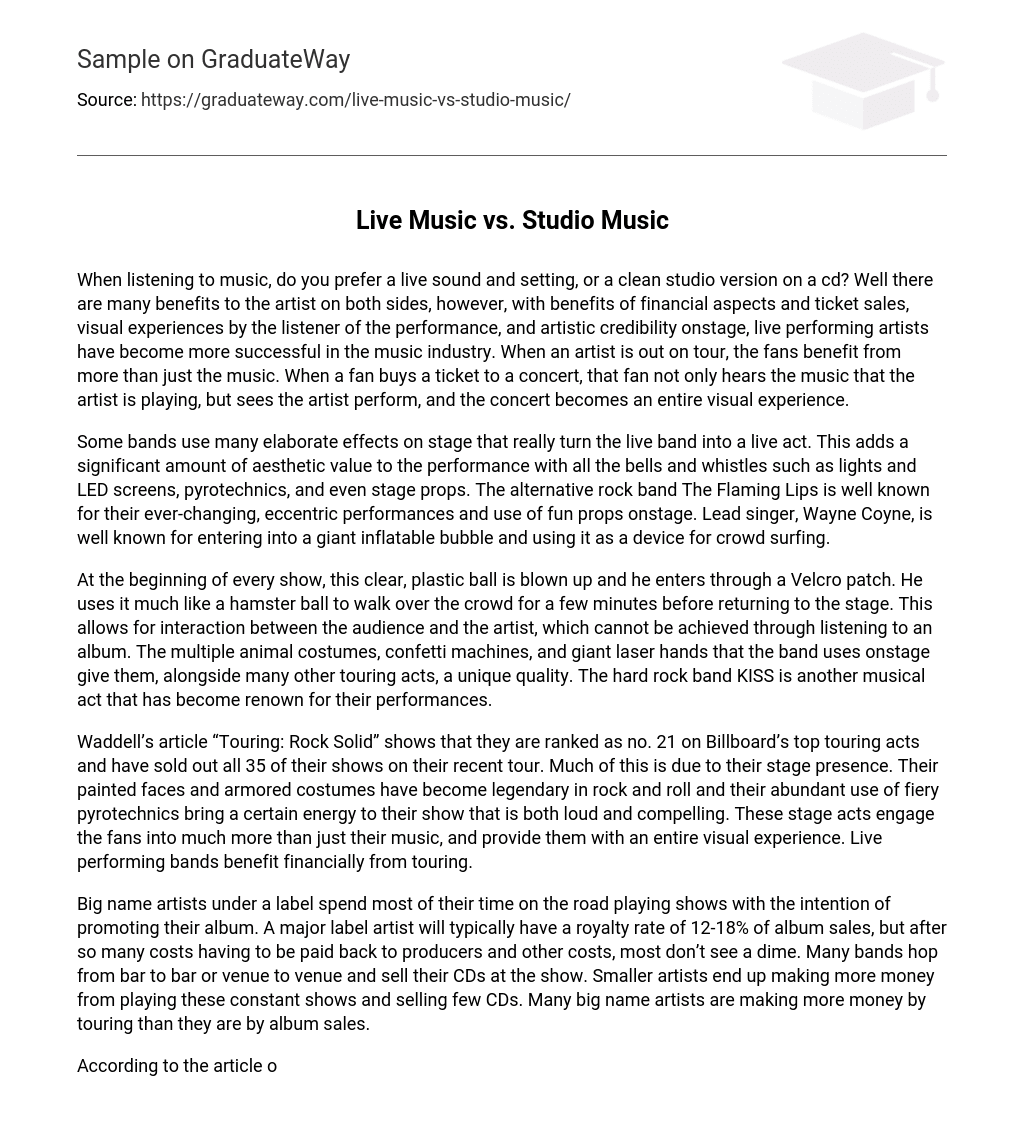When it comes to listening to music, do you have a preference for live performances or studio recordings? Both options offer advantages for artists, but live performers have experienced more success in the industry. This is because they benefit financially from ticket sales, provide enhanced visual experiences for the audience, and gain increased artistic credibility on stage. When an artist goes on tour, fans not only hear their music but also witness their performance. Attending a concert transforms the experience into a complete visual encounter.
Many bands use a variety of effects during live shows to create an immersive experience. These enhancements, such as lights, LED screens, pyrotechnics, and stage props, greatly enhance the visual appeal of the performance. One band that exemplifies this concept is The Flaming Lips in the alternative rock genre. Lead singer Wayne Coyne’s frequent use of a large inflatable bubble during their shows has made them particularly well-known. He skillfully crowd surfs in it.
At the start of each performance, the artist inflates a clear plastic ball and enters through a Velcro patch. This ball serves as a makeshift hamster ball, enabling him to walk over the audience for a brief period before coming back to the stage. This interaction between the audience and the artist is something that cannot be experienced by merely listening to an album. In addition, the band utilizes various animal costumes, confetti machines, and giant laser hands during their performances, giving them a distinctive quality shared by numerous other touring acts. Notably, the hard rock band KISS is also renowned for their live shows.
According to Waddell’s article “Touring: Rock Solid,” Waddell reports that the band Waddell is ranked as no. 21 on Billboard’s top touring acts and has successfully sold out all 35 of their shows on their recent tour. One of the main reasons for their popularity is their captivating stage presence. The band members’ trademark painted faces and armored costumes have become iconic in the rock and roll industry. Additionally, their extravagant use of fiery pyrotechnics adds an energetic and compelling element to their performances. These visually stunning stage acts not only showcase their musical talent but also immerse the audience in a complete sensory experience. It is evident that touring is financially advantageous for bands performing live.
Big name artists signed to a record label often spend most of their time touring and performing shows to promote their album. Although these artists usually receive a royalty rate of 12-18% from album sales, they may have to reimburse various expenses like production costs before making any profit. On the other hand, smaller artists typically travel between bars and venues, selling CDs during their performances. Consequently, these lesser-known artists make more money from live shows and only sell a few CDs. As a result, many well-known artists now earn more income from touring rather than album sales.
According to The Equity Kicker’s website, Bruce Springsteen’s concert sales generated $443 million compared to his album sales of $133 million, indicating a significant difference in revenue. Ticket sales greatly exceed album sales. Additionally, as the market declines, more and more artists are going on tour to promote their albums. Smith mentions that total album sales, including CDs, cassettes, vinyl, and digital albums, decreased by 12.7%, with approximately 374 million units sold compared to the 428.4 million figure from 2008.
Despite the decline in album sales, ticket prices have also been fluctuating but have now stabilized after a recent increase. In 2007, statistics indicate that the average ticket price for the top 100 tours rose by a modest 49 cents to $62.07. Ultimately, touring is more profitable for artists than solely selling albums. Attending a live performance has several advantages for ticket holders but cannot be re-experienced and enjoyed indefinitely.
Engaging in studio work brings ongoing joy and aural sensations. Albums possess a lasting essence that can be enjoyed for extended durations. After a band records an album, it becomes accessible to the public. Production companies often release remastered versions of albums that were recorded and released years ago. These remasters may include subtle changes, creating new opportunities for sales. An exceptional album currently flourishing is Pink Floyd’s groundbreaking masterpiece “Dark Side of the Moon”.
Released in March 1973, this album quickly gained popularity on the Billboard chart and reached number one by April 28. It has since become one of the best-selling albums ever, remaining on the Billboard 200 for an impressive 741 weeks. The Beatles exemplify musicians whose music consistently sells well, with a staggering 30 million albums sold in just the last decade alone. Furthermore, studio recordings and albums offer long-lasting enjoyment and appreciation over time. Although live performances can bring artists significant earnings, it is studio recordings and album sales that have been vital to the success of many musicians in this industry.
Many artists opt not to spend a significant amount of money on organizing tours and instead depend solely on the revenue generated from album sales. An example is Taylor Swift, who sold a total of 4 million albums, making her the highest-selling artist of the year. However, she did not rank among the top-earning touring artists as she spent the year opening shows for Rascal Flatts (Gallo). According to an article, each album has an average price of $12 (Concert Revenue vs Album Revenue). These numbers multiply and prove highly advantageous for the artists.
The Beatles are an example of a studio-based artist and they stopped touring in 1966. However, their album sales have remained successful. According to Ritholtz’s article, Eminem was the top-selling artist of the 2000s selling 32.2 million albums, closely followed by The Beatles who sold 30.2 million albums. Their album sales consistently dominate the charts and even expand into video games as mentioned in “The Beatles: Remasters of the Universe” article.





